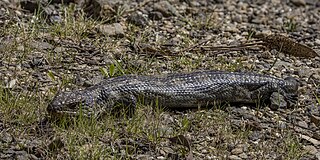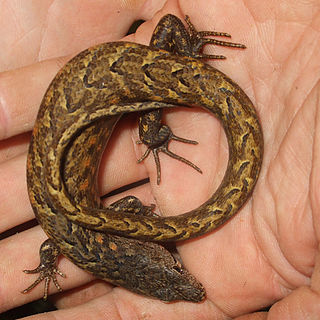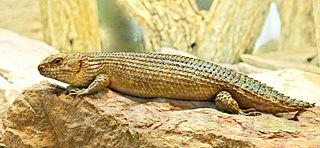
Skinks are lizards belonging to the family Scincidae, a family in the infraorder Scincomorpha. With more than 1,500 described species across 100 different taxonomic genera, the family Scincidae is one of the most diverse families of lizards. Skinks are characterized by their smaller legs in comparison to typical lizards and are found in different habitats except arctic and subarctic regions.

The Solomon Islands skink, also known as prehensile-tailed skink, monkey-tailed skink, giant skink, zebra skink, and monkey skink, is an arboreal species of skink endemic to the Solomon Islands archipelago. It is the largest known extant species of skink.

The pink-tongued skink is a species of lizard in the family Scincidae. It is endemic to Australia, where it is also called commonly the pink-tongued lizard. As suggested by these common names, its distinguishing characteristic is a pink tongue as opposed to the blue tongue of lizards of the closely related genus Tiliqua.

Blue-tongued skinks comprise the Australasian genus Tiliqua, which contains some of the largest members of the skink family (Scincidae). They are commonly called blue-tongued lizards or simply blue-tongues or blueys in Australia or panana in Indonesia. As suggested by these common names, a prominent characteristic of the genus is a large blue tongue that can be bared as bluff-warning to potential enemies. The type of predator/threat that is near will determine the intensity of colour present in the tongue. The tongue can also deform itself and produce a thick mucus in order to catch prey. They are relatively shy in comparison with other lizards, and also significantly slower due to their shorter legs.

The blotched blue-tongued lizard, also known as the southern blue-tongued lizard or blotched blue-tongued skink is a blue-tongued skink endemic to south-eastern Australia.

Tiliqua rugosa, most commonly known as the shingleback skink or bobtail lizard, is a short-tailed, slow-moving species of blue-tongued skink endemic to Australia. It is commonly known as the shingleback or sleepy lizard. Three of its four recognised subspecies are found in Western Australia, where the bobtail name is most frequently used. The fourth subspecies, T. rugosa asper, is the only one native to eastern Australia, where it goes by the common name of the eastern shingleback.

The Tiliqua scincoides scincoides, or eastern blue-tongued lizard, is native to Australia. Its blue tongue can be used to warn off predators. In addition to flashing its blue tongue, the skink hisses and puffs up its chest to assert dominance and appear bigger when in the presence of its predators such as large snakes and birds. The eastern blue tongue is ovoviviparous and precocial, meaning that its young are more developed and advanced at their time of birth. The Tiliqua scincoides scincoides is not venomous to humans and can be found in suburban and urban areas, specifically in house gardens.

Takydromus sexlineatus, the Asian grass lizard, six-striped long-tailed grass lizard, or long-tailed grass lizard, is an arboreal, diurnal species of lizard. The tail length is usually over three times the body length in this species.

The western blue-tongued lizard, also known as the western blue-tongued skink, is a large skink native to Australia. It is one of six species of blue-tongued skinks found in Australia, though further species are found in New Guinea and Indonesia.

The northern blue-tongued skink or northern blue-tongued lizard is the largest and heaviest of the blue-tongued lizards. They are native to Australia and found almost exclusively in the Northern Region. They generally live around 20 years and are commonly kept as pets.

The chevron skink is a large species of skink that is endemic to New Zealand. Previously found across Northland and the northern Auckland Region, it is now found only on the Great Barrier and Little Barrier islands in the Hauraki Gulf. A cryptic forest dweller, it can hide underwater. The chevron skink is the longest species of skink in New Zealand, reaching lengths of up to 340 mm (13 in). It is under threat from introduced rats.

White's skink, also known commonly as White's rock skink, is a species of lizard in the skink family. It was first described in 1804 by French naturalist Bernard Germain de Lacépède. It is endemic to Australia.

Tiliqua scincoides is a species of skink. It is native to Australia as well Tanimbar Island.

The Centralian blue-tongued skink or Centralian blue-tongue is a species of skink, occurring predominantly in the far north-west corner of New South Wales, Australia. It is one of six species belonging to the genus Tiliqua; the blue-tongued skinks and the shinglebacks. This species of reptile classifies as a lizard.

The Merauke blue-tongued skink, also known as the faded blue-tongued skink, or giant blue-tongued skink, is a subspecies of Tiliqua that is native to Indonesia and Papua New Guinea. The Merauke blue-tongued skink is the longest of all the Tiliqua species; often reaching nearly 26-30 inches (66–76 cm) in total length. The species is often exported for the exotic pet trade, and is steadily growing in popularity within both herpetoculture and zoological exhibits globally.

Egernia stokesii is a gregarious species of lizard of the Scincidae family. This diurnal species is endemic to Australia, and is also known as the Gidgee skink, spiny-tailed skink, Stokes's skink and Stokes's egernia. The species forms stable, long-term social aggregations, much like the social groups seen in mammalian and avian species. This characteristic is rarely found in the Squamata order, but is widespread within the Australian subfamily of Egerniinae skinks. Populations of E. stokesii are widely distributed, but fragmented, and occur in semi-arid environments. There are three recognised subspecies. The conservation status for the species is listed as least concern, however, one subspecies is listed as endangered.

Plestiodon brevirostris, the short-nosed skink, is a species of lizard endemic to Mexico.
Typhlacontias punctatissimus, also known commonly as the dotted blind dart skink, the speckled burrowing skink, and the speckled western burrowing skink, is a species of lizard in the family Scincidae. The species is native to southern Africa. Three subspecies are recognized.
The Spinifex slender blue-tongue or Samphire slender bluetongue is an endemic species of skink that inhabits the arid areas of central Australia. The Spinifex slender blue-tongue is closely related to the large blue-tongue skinks. However is individually categorised under the Genus Cyclodomorphus and species Cyclodomorphus melanops(C. melanops).


















